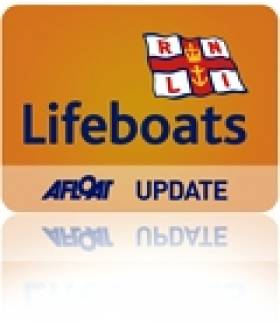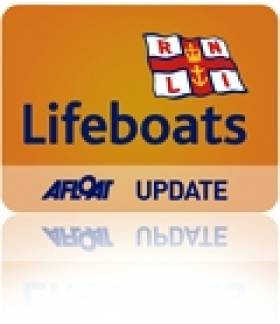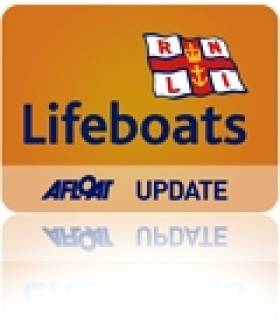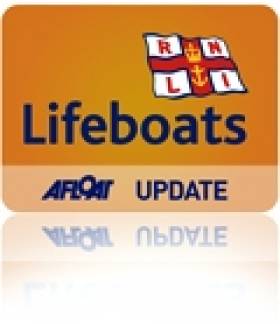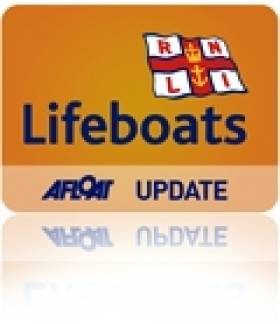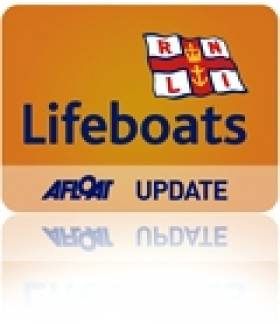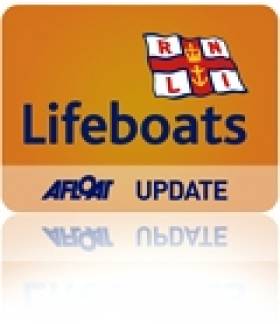Displaying items by tag: Lifeboats
Portaferry Lifeboat Attends Converted Trawler After Power Failure
#RNLI - Portaferry RNLI responded to a mayday call about a converted fishing trawler at Ringhaddy Sound in Strangford Lough on Saturday night (24 August).
The alarm was raised by the crew of a nearby yacht who reported two men and two women on board an 80ft converted trawler, which had lost all power and was taking on water.
The Portaferry lifeboat crew launched before 8pm and were on the scene within 15 minutes. The sea at the time was calm with no wind and good visibility.
When the lifeboat arrived, one man and one woman had already transferred to the neighbouring yacht. The lifeboat crew then requested a salvage pump to help pump the water from the stricken boat.
A local vessel from Portaferry lent assistance by taking a pump to the lifeboat crew, and they met halfway between Portaferry and Ringhaddy.
With the assistance of the crew of the yacht who had called in the alert, the lifeboat manoeuvred the converted trawler onto the pontoons at Ringhaddy, and remained while the last of the water was pumped out and all four of its compliment were safely ashore.
Portaferry RNLI volunteer lifeboat operations manager Brian Bailie said: "We would like to pass on our thanks to everyone who helped bring this mayday call to a safe conclusion.
"The prompt actions of everyone involved resulted in a positive outcome and the volunteer RNLI crew for the second time in as many days helped to avert a potentially very serious situation."
Meanwhile, Donaghadee RNLI also launched on Saturday to go to the aid of a 17ft powerboat with four men on board that had run out of fuel off the Copeland Islands.
Belfast Coastguard received a call from the men shortly after 5pm and requested the lifeboat to launch.
The all-weather lifeboat crew, under second coxswain John Ashwood, located the vessel quickly and the decision was made to tow the casualty back to Donaghadee harbour. All returned safely shortly after 5.45pm.
Wexford, Wicklow and Courtown Lifeboats Have A Busy Few Days
#RNLI - Wexford RNLI rescued two people late on Monday night (26 August) after their yacht went aground on a sandbank on the way into Wexford Harbour.
The volunteer lifeboat crew responded to the report of the yacht which had grounded near Ravens Point around midnight on Monday. Weather conditions at the time were good with a calm sea state and a north westerly force three wind.
But a fast-flowing tide of four knots meant that the inshore lifeboat and crew of the yacht had to work hard to refloat that boat.
Wexford RNLI lifeboat helm Peter Scallan commended the action of the yacht's crew, who he said were experienced sailors.
"The yacht's crew had taken all the correct precautions with the appropriate equipment on board to ensure their safety. They co-operated greatly with the lifeboat crew and as a result both they and their yacht were rescued."
Lifeboat crew member Alan Keville went onboard the vessel to assist in the manoeuvre to get the yacht off the sandbank, which involved using the mast to get the vessel on its side as the keel was stuck hard in the sandbank. The yacht was under tow at 1.14am and back in Wexford at 2.30am.
Elsewhere, the Courtown lifeboat launched on Sunday afternoon (25 August) to a report of a swimmer missing off Ardamine beach.
The lifeboat crew, who were in the harbour at the time, launched within minutes and commenced a search of the area. Irish Coast Guard helicopter Rescue 117 was also tasked to the scene, along with the Courtown coastguard unit.
After a thorough search of the area between Glasscarrig and Courtown pier, all rescue services were stood down as nothing was found. Courtown RNLI thanked all the members of public who helped and provided information during the call out.
The day before, the Wicklow RNLI inshore and all-weather lifeboats were launched after a member of the public reported seeing a small craft with two people drifting off Brittas Bay beach.
While the lifeboats were on route to Brittas Bay, they were requested to stand down and return to station by the coastguard as the boaters managed to make their own way ashore.
Speaking after the call-out, Wicklow RNLI lifeboat operations manager Des Davitt said: "While this turned out to be a false alarm with good intent, we are delighted that the public are being vigilant and contact the coastguard immediately when they suspect someone is in trouble on the water."
#RNLI - Some 46 people completed the 750m course on Lough Erne in the revived Castle Island Charity Swim recently - including three Enniskillen RNLI lifeboat crew in full kit!
As reported last month on Afloat.ie, the swim traditionally took place annually with the support of the Blake family, and Enniskillen RNLI hailed as a "great honour" the chance to bring back the annual event.
Apart from the action on the water on Sunday 11 August, the day featured was a family fun morning on shore with a bouncy castle, face painting and an ice cream stand.
Lifeboat volunteer crewman Adrian Kelly said of the day: "I would like to take this opportunity to thank everyone who got involved on all levels. I really hope everyone enjoyed the event and that we can give it a go next year."
Courtown Lifeboat Comes To Aid Of Stricken 'Jaws'
#RNLI - Courtown RNLI was called out on Saturday (10 August) to assist a sailing boat that had run aground on the Bradleys rocks just south of Courtown Harbour in Co Wexford.
The yacht - called Jaws – had been taking part in the weekly club race and had accidentally drifted onto the rocks with three persons on board.
Fellow yacht Yasemin, which had been taking part in the same race, came to assistance and helped tow the yacht off the rocks.
Yasemin then passed the tow over to the Courtown lifeboat, which proceeded to tow Jaws back into harbour. Courtown Lifeboat was then tasked to assist the yacht Nan, which had suffered engine failure and also required a tow into the harbour.
Holyhead RNLI Rescues Yacht Crew From Reef
#RNLI - The crew of the Holyhead RNLI lifeboat in North Wales have rescued two people from a 32-foot yacht trapped on the Harry Furlong reef half a mile north of Cemaes Bay in the Irish Sea.
The lifeboat crew launched a small Y boat from the Severn and evacuated the pair from the vessel. They were taken aboard the lifeboat and brought to Holyhead.
Although shaken by their ordeal no first aid was required. A small fishing boat stood by during the rescue, and a helicopter from RAF Valley and local coastguard teams were all involved.
Later the same evening, the Holyhead lifeboat crew was requested to secure the vessel and attach a tow. As she refloated, the yacht was towed to Holyhead Marina, where her owner was reunited with her.
Busy Thursday For Wicklow & Wexford Lifeboats
#RNLI - It was a busy afternoon for RNLI lifeboats on the east coast on Thursday 8 August with separate call-outs in Wicklow and Wexford.
Wicklow RNLI's all weather lifeboat Annie Blaker was launched at 3.15pm to answer a call for assistance from a lone yachtsman experiencing mechanical difficulties off Wicklow Head.
As the crew assembled at the station, another call for assistance was received from a boat with four people in the same area.
The lifeboat launched immediately and located the small boat with four on board near Brides Head a short time later, but the occupants were in no immediate danger, so no further assistance was required as the boat was able to return safely to more sheltered waters under its own power.
The lifeboat then proceeded to the stricken yacht, located about two miles east of Wicklow Head shortly after 3.30pm. Weather conditions in the area at the time were described Force 4 with a south west wind.
The boat with the lone sailor was escorted back to Wicklow by the lifeboat. One of the lifeboat crew was transferred onto the yacht outside the harbour to assist with mooring the boat alongside the east pier.
Meanwhile in Co Wexford, the volunteer lifeboat crew at Rosslare Harbour RNLI launched their all weather lifeboat at 11am to assist an 11-metre fishing boat in difficulty.
The Arklow boat became entangled in fishing gear while north of Raven Point on the Wexford coast and lost all power. The fishing boat contacted the coastguard and the Rosslare Harbour RNLI lifeboat was launched and quickly on scene.
The weather conditions were described as good with a southerly Force 3 wind.
The lifeboat crew took the fishing vessel under tow as far as Cahore Point where the Arklow RNLI all-weather lifeboat took over the tow and brought them on to Arklow.
Speaking after the call-out, Rosslare RNLI volunteer deputy press officer Jamie Ryan said: “The emergency services reacted swiftly and help was on scene quickly. The three fishermen took the correct action in contacting the coastguard."
Portrush Lifeboat Assists Dismasted Yacht
#RNLI - Portrush RNLI assisted the crew members of a yacht that lost its mast while out sailing on the River Bann this morning.
The volunteer lifeboat crew were alerted by an observer and launched both the all-weather lifeboat and the inshore lifeboat just before 10am today Tuesday 6 August. The inshore lifeboat was later stood down.
The yacht in question had four people on board and had lost her mast and rigging due to an earlier collision with a navigation marker.
Portrush RNLI came alongside the yacht and passed equipment to her crew to help to stabilise the rigging.
Once this was done, a rope was successfully passed to the yacht to start the tow. This exercise was complicated because the yacht was stuck on the bottom of the river by the rigging and the keel, and the tide was falling fast.
Added to this, the river flow was quite strong, thus making conditions slightly more difficult.
However, due to the skill of the lifeboat crew and the fact that the winds were light, the tow rope was successfully attached and a long slow tow was started.
Mark Mitchell, deputy 2nd cox, said: "This was a tricky operation as the rigging and the sail from the yacht were still in the water, which made progress slow. We had to move at a reduced pace to ensure the tow would be successful. We had to move slowly into deeper water and adjust the tow accordingly."
Lifeboat operations manager Robin Cardwell added: "All the training and experience of our crew was required to ensure a successful outcome of this service. They judged conditions well and made sure the crew and yacht was brought to harbour."
The lifeboat crew towed the yacht to Coleraine Harbour and returned to base.
RNLI Lifeboat Rescues Stranded Kayaker Off Youghal
#RNLI - Youghal RNLI launched yesterday afternoon (5 August) to a report of an object in the water off Redbarn Strand at Youghal - and picked up a stranded kayaker instead.
The volunteer crew was requested to launch their inshore lifeboat at 2.30pm when a member of the public raised the alarm after spotting something in the water.
The lifeboat, helmed by David Slattery with crew members Martin Morris and Joe Moore on board, located the object minutes after launch. It turned out to be a large human hamster ball that apparently had blown into the water from the strand.
While the crew were taking the ball on board, they spotted a lone male kayaker 50 yards away who had lost his paddle and proceeded to his aid.
The kayaker told the lifeboat crew that he had lost his paddle and was drifting for some time. He was very tired after attempting to paddle with his hands and did not have a spare paddle or any form of communication or flares.
Weather conditions at the time were sunny with a moderate to fresh northerly breeze and a one-metre swell.
The lifeboat took the man and his kayak on board and proceeded back to the Youghal lifeboat station, where they checked if he was in need of any medical attention.
Youghal RNLI lifeboat press officer Noreen Varney said: “It was a very fortunate set of circumstances for the kayaker to be rescued from what originally was a non-related incident.”
Courtmacsherry RNLI Rescues Two In Early Morning Capsize
#RNLI - Two men were rescued in the early hours of this morning (Sunday 4 August) after their small boat got into difficulty off the pier at Courtmacsherry Harbour in West Cork.
Fourteen crew of the Courtmacsherry RNLI all-weather lifeboat station responded immediately to the Mayday call at 4.25am and the two casualties were pulled ashore from the water after the small boat which they were in capsized.
Following an 999 call from two local people, the Irish Coast Guard immediately tasked the Courtmacsherry lifeboat and the Shannon-based coastguard rescue helicopter.
Within minutes the small craft had overturned and the two young men on board were thrown into the water. Without delay, crew members and helpers succeeded in getting a lifebelt from the pierced to one of the casualties, while the other man was helped ashore at the pierhead.
The two men, both from Cork City, were said to be "shocked and traumatised" by their ordeal after they were brought back to the lifeboat station in Courtmacsherry to be assessed by station crew and officers. Conditions at sea this morning were good with little wind.
Courtmacsherry RNLI lifeboat operations manager Brian O'Dwyer said the men "had a very lucky escape in the early hours of this morning" and praised the fast response of the lifeboat crew members, local helpers and emergency services for "certainly averting a potential life threatening situation".
Crosshaven RNLI In Early Hours Search For Missing Person
#RNLI - The Crosshaven RNLI volunteer crew were paged in the early hours of Saturday 3 August to reports of a missing person separated from friends at Salve Marina near Cork Harbour.
The lifeboat, with Alan Venner, Kieran Coniry and Denis Cronin on board, was launched along with Crosshaven coastguard and the Irish Coast Guard's Rescue 115 helicopter, to made multiple searches of all the marinas and the Owenboy River, until reports were received from Gardaí that the missing person had been located at his home address.
The lifeboat was then stood down and returned to station, refuelled, washed, and ready for service at 5am.
Commenting on the service, lifeboat station manager Alan Barton said: "Thankfully, this did not end in a tragedy. The friends of the missing person took the correct course of action by calling us – a false alarm with good intent."


























